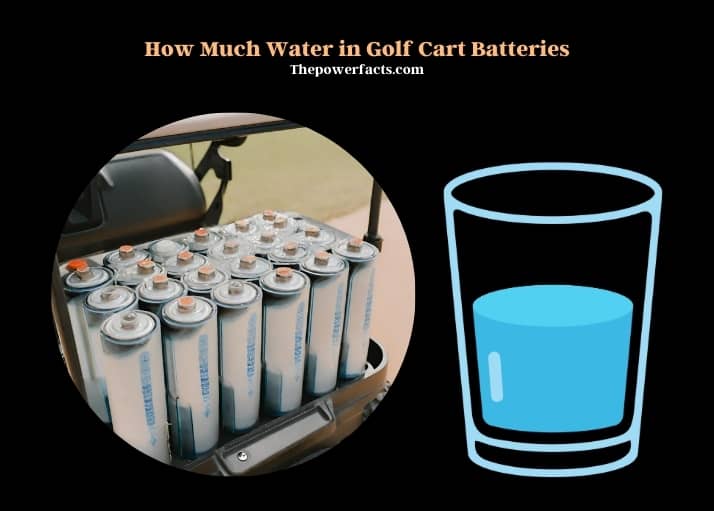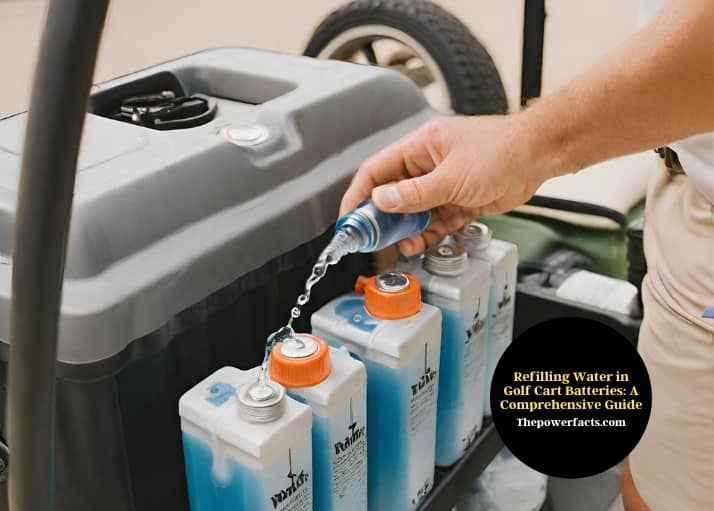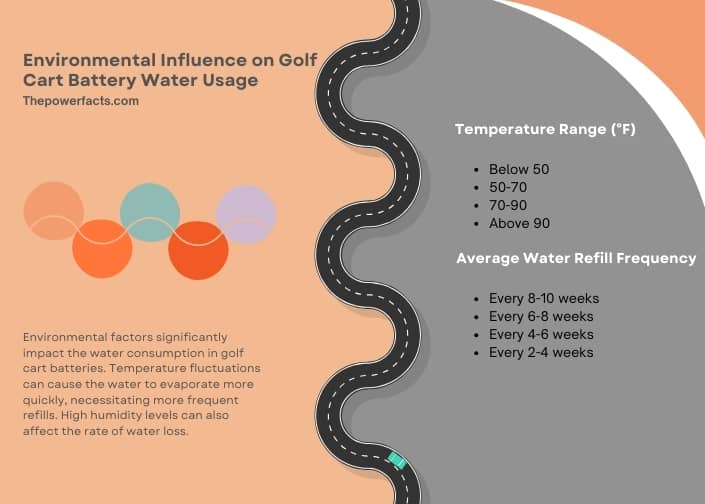The amount of water needed in golf cart batteries varies, but generally, it should be enough to cover the lead plates by about half an inch. This level ensures optimal performance and longevity of the battery.
Maintaining the correct water level in golf cart batteries is a critical aspect of their upkeep. These batteries, typically lead-acid types, require water to facilitate the chemical reaction that produces electricity. The water level should be checked regularly, ideally after the battery has been fully charged. This is because charging can cause the water to expand, giving a false reading if checked beforehand.
Using distilled water is essential as it prevents the buildup of minerals that can degrade battery performance. Overfilling the batteries can lead to overflow during charging, which not only dilutes the electrolyte solution but can also cause damage to the battery and the golf cart. Conversely, low water levels expose the lead plates to air, leading to oxidation and reduced battery efficiency.

Environmental factors, such as temperature and humidity, also play a role in how quickly water levels decrease, necessitating more frequent checks and top-ups in extreme conditions. Proper maintenance of water levels in golf cart batteries is not just about prolonging their life but also about ensuring the safety and reliability of the golf cart.
Ensuring Optimal Water Levels in Golf Cart Batteries
Maintaining the right water level in golf cart batteries is vital for their longevity and performance. These batteries typically require regular water top-ups to function effectively. The recommended water level is crucial; it should cover the lead plates inside the battery but not exceed the maximum limit to prevent overflow during charging. Different types of golf cart batteries might have varying water level requirements.
Regular monitoring and maintenance can significantly extend a battery’s life. It’s essential to use distilled water to avoid mineral buildup, which can impair battery performance. Adhering to these guidelines ensures that your golf cart battery remains efficient and durable.
Water’s Crucial Role in Golf Cart Battery Efficiency
Water in golf cart batteries plays a pivotal role in their functionality. In these lead-acid batteries, water is a key component of the electrolyte solution, which facilitates the chemical reaction necessary for electricity generation. The balance between water and sulfuric acid in the electrolyte is critical. If the water level drops too low, the acid concentration increases, leading to decreased battery efficiency and potential damage. In contrast, dry-cell batteries, which don’t require water, operate differently and are less maintenance-intensive.
For golf cart batteries, maintaining the correct electrolyte balance is essential for optimal performance and longevity.
Refilling Water in Golf Cart Batteries: A Comprehensive Guide
Refilling water in golf cart batteries is a straightforward but essential task. Safety is paramount; always wear protective gear and ensure the golf cart is turned off. The tools required for this task include a distilled water container and a funnel or watering gun. The best practice is to refill the water after charging the battery, as this prevents overfilling.
The frequency of refilling depends on usage but checking monthly is a good rule of thumb. Using distilled water is crucial to prevent mineral deposits that can harm the battery. By following these steps, you can ensure your golf cart battery remains in top condition.

Identifying and Resolving Water Level Problems in Golf Cart Batteries
Detecting water level issues in golf cart batteries is key to preventing long-term damage. Signs of low water levels include diminished performance and overheating. If you notice these symptoms, check the water level and refill if necessary. Troubleshooting methods include ensuring the charging system functions correctly and that the battery is not overcharged.
Preventive measures, such as regular checks and maintenance, can help avoid these issues. In some cases, seeking professional maintenance advice is advisable to ensure the longevity and efficiency of your golf cart battery.
Environmental Influence on Golf Cart Battery Water Usage
Environmental factors significantly impact the water consumption in golf cart batteries. Temperature fluctuations can cause the water to evaporate more quickly, necessitating more frequent refills. High humidity levels can also affect the rate of water loss. Seasonal changes, particularly extreme temperatures, can have a notable impact on water usage.
Proper storage conditions, such as keeping the golf cart in a temperature-controlled environment, can help mitigate these effects. The following table illustrates the impact of various climate conditions on golf cart battery water consumption:
| Temperature Range (°F) | Average Water Refill Frequency |
| Below 50 | Every 8-10 weeks |
| 50-70 | Every 6-8 weeks |
| 70-90 | Every 4-6 weeks |
| Above 90 | Every 2-4 weeks |

FAQs
Can Overfilling Water Damage Golf Cart Batteries?
Overfilling water in golf cart batteries can indeed cause damage. Excess water in the battery cells leads to overflow during charging. This overflow can dilute the electrolyte solution, reducing the battery’s efficiency and lifespan.
It can cause corrosion and damage to the battery components and the surrounding area of the golf cart. To avoid overfilling, it’s essential to fill the water just above the lead plates and below the maximum fill line. Regular checks and careful maintenance are key to preventing overfilling and ensuring the battery’s optimal performance.
Is Distilled Water Necessary for Golf Cart Batteries?
Using distilled water in golf cart batteries is highly recommended. The reason lies in the purity of distilled water; it is free from minerals and impurities found in tap water. These minerals can accumulate in the battery, leading to decreased efficiency and potential damage.
Distilled water ensures the electrolyte solution remains balanced, which is crucial for the battery’s proper functioning. While using non-distilled water isn’t immediately harmful, it can lead to long-term issues, making distilled water the safer and more efficient choice.
How Does Battery Age Affect Water Usage?
As golf cart batteries age, their water usage patterns can change. Older batteries may require more frequent water top-ups. This change is due to the natural degradation of battery components over time, which affects the efficiency of the chemical reactions within the battery.
The plates inside an older battery may become less effective, leading to increased evaporation and consumption of water. Regular monitoring of water levels becomes even more important as the battery ages to ensure it continues to function effectively and safely.
What Are the Risks of Low Water Levels in Golf Cart Batteries?
Low water levels in golf cart batteries pose several risks. If the water level drops below the top of the lead plates, it can lead to irreversible damage. The exposed plates can become oxidized, reducing the battery’s capacity and lifespan.
Low water levels increase the concentration of sulfuric acid, which can lead to overheating and increased wear on the battery. Regularly checking the water level and maintaining it within the recommended range is essential to prevent these risks and ensure the battery’s longevity.
Can Weather Conditions Affect Water Levels in Golf Cart Batteries?
Weather conditions can significantly affect the water levels in golf cart batteries. High temperatures can increase the rate of water evaporation, necessitating more frequent top-ups. Conversely, in colder climates, water evaporation occurs at a slower rate, but the battery’s charging efficiency can be reduced, which might still affect water levels.
It’s important to adjust maintenance routines according to the prevailing weather conditions to ensure the battery remains properly hydrated and functional.
Should Water Levels Be Checked Before or After Charging?
It’s advisable to check and adjust the water levels in golf cart batteries after charging. During the charging process, the water in the battery heats up and expands, which can give a false reading if checked beforehand. Filling water after charging ensures that the levels are correct and reduces the risk of overfilling.
This practice helps in maintaining the right balance of the electrolyte solution, which is crucial for the battery’s optimal performance and longevity. Regular post-charge checks are a key part of effective battery maintenance.
Summary
Maintaining the correct water level in golf cart batteries is crucial for their efficiency and longevity. Understanding the role of water in these batteries, following a proper refilling guide, being aware of potential issues, and considering environmental factors are all key to optimal battery maintenance. Regular checks and adherence to maintenance guidelines will ensure your golf cart battery remains reliable and efficient.